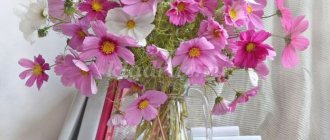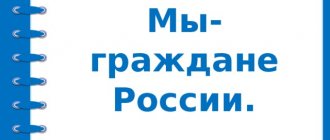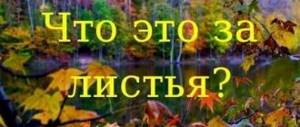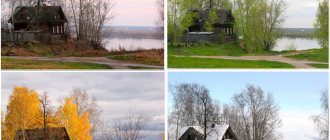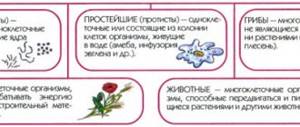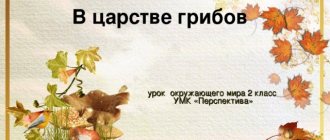MAGAZINE Preschooler.RF
Summary of a biology lesson in 6th grade on the topic: “Flower.”Purpose of the lesson: to expand knowledge about the structure of angiosperms; get to know the structure of a flower. Educational objectives: 1. Study the structural features of a flower 2. Show the connection between the structure of a flower and the function it performs 3. Develop in students new knowledge about the structure of plants Developmental objectives: 1. Develop imaginative logical thinking and independence of students. 2. Develop the cognitive abilities and interests of students. 3. Develop the concept of a flower as a modified shoot.
Download the abstract Educational objectives: 1. Show that angiosperms have shown their potential for evolutionary perfection most of all in the field of generative organs, using hidden capabilities within the already existing structures of the vegetative body. 2. Consider the variety of flowers and their significance for plants. 3. Fostering a caring attitude towards plants. Methodological methods and techniques: a story with elements of conversation and using presentation, flannelograph. Laboratory work. Equipment: multimedia projector, presentation of a lesson on the topic “Flower”, flannelgraph and flower model, tables of the structure of a flower. Handouts—flowers of various plants, magnifying glasses, blades or scalpels, instruction cards. Literature used: textbook by V.A. Korchagina, reference materials on biology edited by D.I. Traitak Lesson progress: ORGANIZATIONAL MOMENT Good afternoon, guys! I am glad to welcome you all to my lesson! KNOWLEDGE UPDATED • What are the different plant organs? (Answer: vegetative and generative.) • Name the vegetative organs of plants? (Answer: root and shoot, the shoot consists of a stem, leaves and leaves and buds located on it).
We open our notebooks and write down the date and topic of the lesson. To find out the topic of the lesson, guess the riddle.
“There is a cherry blossom castle on a high hill. The fortress wall of the castle is two-row. In the first row around the castle there are five green battlements, and in the second there are five large white walls. There is a pillar in the center of the castle, and fluffy pillows swing around on thin legs.” What kind of castle is this? That's right, the theme of the lesson is “Flower”
Flowers, like people, are generous with love, And generously giving tenderness to people, They bloom, warming hearts, Like small warm fires.
Today in the lesson you will learn about the structure of a flower.
• Guys, do you think a flower belongs to vegetative or generative organs? (Answer: a flower belongs to generative organs) That's right, guys, the word generative comes from the Latin word “generation”, which means birth, reproduction. A flower is an organ of seed reproduction.
STUDYING NEW MATERIAL Structure of a flower Flowers arose long before the appearance of man. Plants did not invent the flower in order to make us feel beautiful; they had other purposes for this purpose, aimed at survival. And yet, when we see flowers, we experience a feeling of beauty, we admire the beauty of flowers.
A flower is a modified shortened shoot used for seed propagation of plants. A flower develops from a generative (flower) bud.
No matter how great the variety of flowers of the plants around us is, similarities can be found in their structure. Let's look at the structure of a flower. The thin stalk on which the flower sits is called the peduncle, and its upper, expanded part is called the receptacle. Any flower has main organs - the pistil and stamens, which also have a special structure. The pistil is the female organ of a flower; it has a stigma, a style and an ovary. In an apple tree, the pistil is formed by five columns fused together at the base. In the upper part they are free and each bears one stigma. The ovary is five-lobed. The nests contain ovules, from which seeds develop after flowering. Stamens are the male organs of a flower; each stamen has an anther, inside which pollen ripens. The anther is located on the filament. The perianth is located around the main organs of the flower: the pistil and stamens. The inner leaves are petals and form a corolla. The outer leaves - sepals - form a calyx. The calyx can be either fused-leaved or septate-leaved. There are separate-petalled and fused-petaled corollas. The perianth can be double or simple. In an apple tree, the perianth consists of a calyx and a corolla. This type of perianth is called double. In a tulip, all the tepals are the same. Such a perianth is called simple. Most plants have flowers that contain both pistils and stamens. Such flowers are called bisexual. But in some plants (cucumber, corn), some flowers have only pistils - pistillate flowers, while others have only stamens - staminate flowers. Such flowers are called dioecious.
Plants such as cucumbers and corn are called monoecious because they develop pistillate and staminate flowers on the same plant. Hemp, poplar and willow are called dioecious plants because they have staminate flowers on some plants and pistillate flowers on others. Flowers are evolutionarily the most perfect organ in structure and function among other plant structures. Flowers are best adapted to the diverse habitats of angiosperms.
Flowers are not meant to be plucked, but so that we can selflessly appreciate their beauty where they grow! (R. Gagor)
CONSOLIDATING KNOWLEDGE Guys, we studied the structure of a flower. Now, so that you can rest a little, I suggest you solve a few riddles.
3 riddles.
Now we’ll see how you listened to me carefully, and for this we’ll play a game called “Do you know the structure of a flower.” (The teacher reads the text, and the guys listen carefully; if there is a mistake, the guys clap their hands. The teacher asks the student, he corrects the mistake). The axial part of the flower, on which all its parts are located, is called the corolla (receptacle). The double perianth consists of a corolla and a calyx. The calyx of a flower is formed by petals (sepals), and the corolla by sepals (petals). The perianth performs the function of protecting the main parts of the flower. The main parts of a flower are the ovary and corolla (pistil and stamens). The stamen consists of the filament and anther, the pistil - of the stigma, style and pedicel (ovary).
Conclusion: Guys, each of you must remember that any plucked flowering plant is an irretrievably perishing organism!
Now we will do laboratory work. I will give you flowers of various plants that you will have to work with.
Instruction card.
1. Look at the flower. Find the peduncle, receptacle, perianth, stamens and pistil. 2. Dissect the flower, count the number of sepals, petals, and stamens. 3. Determine which perianth this flower has - simple or double. 4. Determine which calyx is septate or fused-leaved, which corolla is free-petalled or fused-petalled. 5. Consider the structure of the stamen. Find the anther and filament. Examine the anther under a magnifying glass. 6. Consider the structure of the pistil. Find its parts. Cut the ovary crosswise and look under a magnifying glass. Why are the stamens and pistil the main parts of a flower? 7. Draw the parts of the flower and label their names.
CONCLUSION A huge number of beautiful lines are dedicated to flowers, for example G. H. Andersen said: “To live, you need the sun, freedom and a small flower.”
And in conclusion, I will read you a poem: You, Man, loving nature, At least sometimes feel sorry for it. On pleasure trips, do not trample its fields. Don’t burn it recklessly And don’t exhaust it to the bottom, And remember the simple truth There are many of us, but there is only one!
HOMEWORK 1) Textbook paragraph 2) Answer the questions: - Why can heavy rains over the garden in the spring cause crop failure? — Why do you think flowers pollinated by insects have brighter colors and more petals? — Why are wind-pollinated flowers smaller than animal-pollinated flowers? 3) Draw a diagram of the structure of the flower, label all the components. 4) Compose your own crossword puzzle on the structure of a flower (at least 10 words). RESULTS OF THE LESSON Grading for the lesson The lesson is over. Thanks everyone! All the best!
| Next > |
Download material
so UNT / Lesson developments / Biology lessons
Synopsis for biology lesson “Flower. Structure and meaning of a flower" 6th grade
04/09/2015 5691 991 Salykova Mira Markenovna Purpose of the lesson: to develop students’ knowledge about the structure and functions of a flower as a generative organ of angiosperms.
Objectives: Developmental: • formation of skills to analyze, highlight distinctive features in the structure of flowers of various groups of plants, develop logical thinking; • continue to develop skills to work with natural objects; • development of cognitive interest.
Educational: • ensure that students acquire knowledge about the structure of a flower; • form the concepts of “bisexual” and “unisexual” flowers; • continue the ability to work with a textbook, drawings; • develop skills in working with handouts;
Educational: • cultivate a positive attitude towards living nature; • instill communication skills, development of a sense of beauty.
Teaching methods: explanatory-illustrative, partially search.
Lesson type: learning new material.
Form of organization of educational activities: combined.
Equipment: multimedia board, screen, school board, collapsible models: “cherry blossom”, “potato flower”, glue
During the classes. 1.Organizational stage. Hello guys! I'm glad to see you all today! I think that our joint work in class will be interesting and useful. I want to start our lesson with a fairy tale: “One day a small seed fell to the ground. How did it happen? Perhaps a bird dropped it? Or maybe it was brought by the wind... Or some animal could have thrown it. A little time passed and a miracle happened: a sprout with tiny leaves and small roots appeared from the seed. But thanks to the sun, the sprout became bigger and bigger, stronger and stronger. Finally, the sprout turns into a real plant with many leaves... And then, what do you think will happen next? What else is missing from the plant? Soon the plant produces a bud. Over time it will open up and turn into a beautiful flower. Epigraph to the lesson: “Let's walk slowly through the meadow! (slide2) And we say “Hello” to every flower, I must bend over the flowers, Not to pick them or cut them, But to see their kind faces And show them a kind face. Samed Vurgun
Let's smile at each other, tune in to search and creativity, and continue our lesson. The topic of our lesson is “Flower. The structure and meaning of a flower" (write on the board and in a notebook).
2. Updating knowledge. Today in class we will continue to study plant organs. Let's remember which organs you already know? (students list organs). You have a story on your desk with biological errors. (slide 3)
The leaves of different plants differ in appearance. Most leaves consist of two parts: the leaf blade and the petiole. Such leaves are called petiolate. Petiolate leaves have wheat, flax, and aloe. The leaves also vary in shape of the edge of the blade. For example, a lilac leaf has a serrated edge, an apple leaf has a serrated edge, and an aspen leaf has a whole edge. Based on the direction of growth, stems are divided into erect, climbing and sessile.
Error comments.
3. Studying new material. You have studied the organs of flowering plants: root, stem, shoot. (slide 4) Today we will talk about flowers. We will not only admire the beauty of flowers, but also study their structure. Think about whether all plants produce them. (Children answer). Flowers are produced only by flowering plants. (slide 5) Flowers come in a wide variety of shapes and colors and attract human attention. For many millennia, flowers have symbolized the beauty, joy and perfection of nature among people. The flower is the most visible, often beautiful, important part of angiosperms. Flowers can be large or small, brightly colored and green, fragrant or odorless, solitary or collected in inflorescences." Although there is a huge variety of flowers in the world, they all have a single structural plan and are united by the most important function in plant life - the formation of fruits and seeds for the reproduction of the organism.. So what is a flower? (slide 6) A flower is the organ of seed reproduction of flowering plants. (We write down the definition in a notebook)
(slide 7) We will study the structure of the parts of a flower together with you. Open your textbooks, on page 78 there is figure 35 “Structure of a flower.” Be careful, I ask questions, you answer, we work with the textbook. The flowers of many plants are placed on thin stalks-peduncles. The upper end of the peduncle on which the flower is located is called the receptacle. . This is the axis of the flower; all parts of the flower are located on it.). The main parts of a flower are the pistil and stamens. . The pistil is located at the very top of the receptacle (one or several); the stamens are located just below it. The petals are located even lower on the receptacle; their totality forms the corolla. Beneath them are the sepals that form the calyx. The corolla and calyx together create the perianth. This is the brightest part of the flower. The perianth can be simple or double. The main function of the perianth is to protect the reproductive organs of the flower and attract insects. A perianth in which the calyx and corolla can be distinguished is called double (slide 8). A perianth in which neither the calyx nor the corolla can be distinguished is called simple. (we write down the definitions in a notebook). There are flowers without perianths. These are the so-called naked flowers. (slide 9) Let's look at the main parts of a flower: pistil and stamens. The pistil, for example, of a cherry, consists of three parts: the ovary, the style and the stigma. The tulip has no column in the pistil. Its stigma sits directly on the apex of the ovary. The stigma is usually sticky, rough or even branched. It serves to receive pollen. The style raises the stigma, sometimes placing it high above the perianth. (slide 10) The lowest, swollen part of the pistil is the ovary. It contains ovules. One ovule develops in the ovary of a cherry, while a tulip has many of them. Therefore, a cherry flower develops a single-seeded fruit, while a tulip develops a multi-seeded fruit.
Physical exercise. Now we will do an exercise to relieve muscle tension. 1.Squat down. 2. Lower your head and arms. Imagine that you are seeds from which beautiful flowers grow. 3. Now a warm ray of sun reached the ground and warmed the seed in it. 4. A sprout sprouted from the seed and a beautiful flower grew from the sprout. Stand up, raise and spread your arms to the sides. 5.A flower is basking in the sun. It exposes each petal to warmth and light, turning its head to follow the sun. 6. Raise your chin, imagine that you are looking at the sun from under lowered eyelids, smile slowly turning your head left and right.
From the ovary of the pistil, after pollination and fertilization, the fruit develops, and from the ovules, seeds are formed. The stamens of cherry and tulip consist of a long, thin filament and a large anther. Pollen develops inside the anther. A cherry flower has many stamens; a tulip has only six. The pistil and stamens are involved in fertilization and fruit formation, which is why they are called reproductive or reproductive organs. (slide 11) The pistil is the female part of the flower, located in its central part, and the stamen is the male part. Most flowers have both a pistil and stamens. There are flowers that have either stamens or pistils. A flower that has a pistil and stamens is called bisexual (cherry, bird cherry, lily of the valley, apple tree, tulip, cabbage) (slide 12). If a flower has either a pistil or stamens, it is called unisexual (cucumber, poplar, sea buckthorn, alder (slide 13). (Scheme on the board) Flowers
Staminate Pistillate Staminate Male Female Pistillate We got acquainted with the structure of a flower, please tell us what is the significance of a flower in nature? In human life? What are they needed for? Look around, how many colors surround us? Why do we admire them so much? (slide 14). Conclusion: the meaning of the flower: attracting pollinating insects, producing fruits and seeds.
There is an expression: “children are the flowers of life.” Explain how you understand this expression. A flower is like a child; it needs to be looked after, cherished, and treated with care. At all times, people admired flowers; they wrote poems, songs, and legends about them. (slide 15). 4. Creative work – prepare a legend about flowers. 5 Laboratory work No. 14 (appendix) Consideration of the structure of a flower 6 Fixing the material. 7. Reflection. Guys, this is where our lesson ends. In the atmosphere and environment in which we worked today, each of you felt differently. And now I would like you to evaluate how internally comfortable each of you felt in this lesson. Describe your mood, what is it like after the lesson? (slide 16) Have you opened up like this rose, or have you not yet opened up like this bud? Choose and show what suits your mood. (slide 17) Thanks for the lesson!
See the downloadable file for the full text of the material.
The page contains only a fragment of the material.
